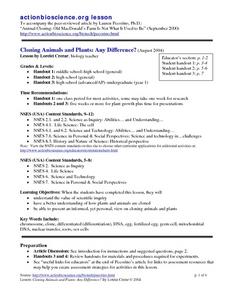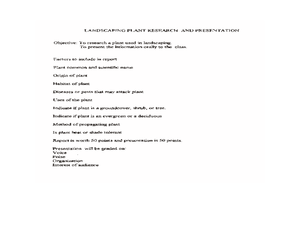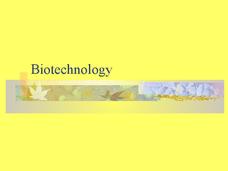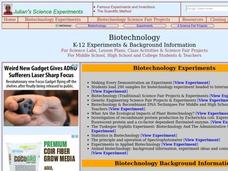Curated OER
Cloning Animals and Plants: Any Difference?
Students examine the process in which plants and animals are cloned. They compare and contrast the two procedures and determine if there is a difference. They share their views on cloning to the class.
Curated OER
Plants, Plants, and More Plants
Young scholars examine several types of plants. In this plant instructional activity, students complete activities that require them to identify types of plants, chart plant anatomy, and explain plant propagation.
Curated OER
Cloning
In this cloning worksheet, students will read a paragraph about how cloning has been a benefit to medicine and agriculture. Students will underline the main idea in the paragraph and write down three supporting details. Then students...
Curated OER
Pete And Repeat
Students draw a picture of a person from popular culture, then "clone" it using printing techniques in this Art lesson plan that tackles the questions surrounding cloning, DNA, and current scientific techniques. An emphasis is placed on...
Curated OER
Biotechnology
A continuous cascade of information comes through this PowerPoint on biotechnology. The topic is defined, a history is presented, and basic genetic engineering techniques are explained. The topic is covered in an objective manner,...
Curated OER
Cloning a Living Organism
It's the attack of the clones! Not to worry; these are just plant clones. Teen horticulturalists will enjoy growing their own clone into a plant in an activity designed to be revisited after a few weeks. It is one experiment that kids...
Curated OER
Whose Life Is It?
Students consider the implications of cloning. In this science and ethics lesson plan, students consider when cases of cloning are ethical and when they are not as they discuss scenarios and their discussion questions.
WK Kellogg Biological Station
Plotting Phenology
Finally, a worksheet that involves more than filling in some blanks. Your budding ecologists must graph and analyze three sets of data, then synthesize the information as they think about the impacts of plant reproduction on insects and...
Curated OER
Plant Reproduction
In this plant reproduction worksheet, students complete a crossword puzzle with 36 questions. They identify the different plant reproductive features.
Curated OER
Genetic Engineering
Students examine the advantages and disadvantages of genetic engineering. For this genetics lesson students simulate the genetic engineering of a human insulin gene.
Curated OER
Solve the Case!
Students discover the habits of panthers by solving fictitious crime mysteries. In this animal life lesson, students utilize their research from previous lessons to solve mysteries in a panther activity. Students answer...
Curated OER
Biotechnology
Students explore biotechnology through various activities. For this biology lesson, students analyze its pros and cons. They study and read informative articles about biotechnology.
Science Buddies
Science Buddies: Attack of the Killer Cabbage Clones
Do you like to watch outdated science fiction and cheesy horror movies? Many fictional tales of cloned organisms have been created based upon the scientific method for cloning animals or plants. In the real world, the cloning of plants...
CK-12 Foundation
Ck 12: Life Science: Cloning
[Free Registration/Login may be required to access all resource tools.] Cloning is the process of creating an exact replica of an organism. The clone's DNA is exactly the same as the parent's DNA. Bacteria and plants have long been able...
BBC
Bbc: Gcse Bitesize: Mitosis and Cell Specialisation
This lesson focuses on cloning. Plants can make identical copies of themselves by asexual reproduction, for example by tubers and runners. Humans have been cloning plants for years and have recently started to develop techniques to clone...
CK-12 Foundation
Ck 12: Life Science: 3.18 Cloning
Understand the science and ethics behind human or animal cloning.
University of Illinois
University of Illinois Extension: Plantenstein Is the Suspect!
Detective Le Plant has discovered that one plant can produce many other plants. He needs you to help him find out how this happens. Follow along and learn about the parts of flowers and reproduction. Along the way, you will be quizzed!
Khan Academy
Khan Academy: Recombinant Dna Technology
Read a passage about recombinant DNA technology and answer the follow-up questions.
McGraw Hill
The Mc Graw Hill Companies, Inc.: Asexual Reproduction
The succinct site covers what asexual reproduction is in plants, describes how stolons and rhizomes produce new plants, and discusses human cloning techniques.
Biology Pages
Kimball's Biology Pages: Asexual Reproduction
Site from Kimball's Biology Pages provides information on Asexual Reproduction in plants, and also in animals, where it is less common. Includes information on stems, leaves, roots, plant propagation and apomixis.
BiologyWise
Biology Wise: What Is Vegetative Reproduction
Explains the method of asexual reproduction in plants known as vegetative reproduction and what its advantages and disadvantages are.
Other
Kitchen Culture Kits, Inc.: Plant Tissue Culture
An excellent site for learning about plant tissue culture. Great visuals and easy to understand instructions. Lots of links to other good sources.





















